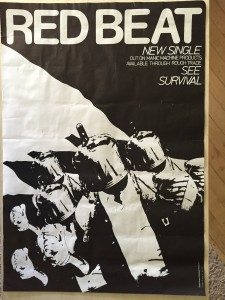
Red Beat formed in High Wycombe in 1978. After building up in solid fan base in the Home Counties they moved to London to pursue their musical ambitions. In London they recorded an EP that was released on Indie label Malicious Damage and did what most do it yourself punk bands would have killed to do: record a John Peel session. They also supported bands such as U2, Killing Joke, Thompson Twins and Aswad.
Originally inspired by New Wave acts such as Blondie and XTC, their later sound was more experimental, influenced by bands like PiL, Siouxsie and the Banshees and Killing Joke.
Roy Jones, singer and driving force behind getting Red Beat’s archive digitised explains that ‘we wrote together by jamming for hours till something sparked.’ Later evolutions of the band had more of a ‘pop orientation’ underscored by ‘a dark sound that fused Punk and Reggae and Tribal Beats.’ Songs by the band include the sci-fi inspired ‘Visit to Earth’ , ‘Ritual Sacrifice,’ a lamentation on the futility of war and ‘Searching for Change’, which explores the need for personal, spiritual and political transformation.
Video Synthesizers
In 1982 Red Beat formed their own indie label, Manic Machine Products, and released two further singles ‘See/Survival’ and ‘Dream/Dream Dub’, both distributed by Rough Trade.
The video of ‘Dream/ Dream Dub’ is the only existing video footage of the band at the time.
Roy’s motivation for sending it to Greatbear was to get the best quality transfer that he will then remaster, add a clean sound track to and upload to the Red Beat youtube playlist.
Of particular interest is ‘Dream/ Dream Dub’s use of video synthesizer footage which was, Roy tells me, ‘quite unique at the time. This footage was then edited with two tape analogue technology which is slow and not as accurate as modern editing.’
As Tom DeWitt explains ‘technically, the video synthesizer is more complex than its audio cousin. Video signals cover a frequency spectrum 100 times greater than audio and must be constructed according to a precise timing synchronization which does not exist in the one dimensional audio signal.’
In the early 1960s and 1970s, synthesizing video images was an emergent form of video art. Artists Shuya Abe and Nam June Paik created one of the first ‘video devices intended to distort and transform the conventional video image.’ [1] Part of their aim was to challenge the complacent viewer’s trans-fixation on the TV screen.
In the 1970s the artistic palette of the video synthesizer evolved. Bill Hearn was instrumental in developing ‘colorisation’ in 1972, and in 1975, Peter Sachs Collopy tells us, he incorporated this tool into ‘a full-featured synthesizer, the Videolab, which also produced effects like switching, fades, dissolves, wipes, and chromakey.’ [2]
‘Colourisation’ is a big feature of the Red Beat video. It refers to the ability to change the appearance of colours by mixing either the red, blue and green elements or the video colour parameters: luminance, chrominance and hue. In ‘Dream/ Dream Dub’ the red, green and blue colourisation is applied, accentuating the primary colours to give the image a garish, radioactive and extra-terrestrial quality.
Want more Red Beat?
If this article has sparked your curiosity about Red Beat you can buy their albums Endless Waiting Game and The Wheel from itunes.
The final word about the band must go to Roy: ‘We were part of a vibrant music scene. Other people enjoyed more success than us but we had a great time and created some great memories. I don’t think many people would remember our music but there are a few who buy our albums and remember seeing us live. We created our own bit of rock’n roll history and it’s worth documenting.’ [3]
Notes
[1] Chris Meigh-Andrews, A History of Video Art (London: Bloomsbury, 2013), 136.
[2] Peter Sachs Collopy ‘Video Synthesizers: From Analog Computing to Digital Art,’ IEEE Annals of the History of Computing, 2014, 74-86, 79.
[2] Thank you to Roy for generously sharing his memories of Red Beat and to Peter Sachs Collopy for sharing his research.

